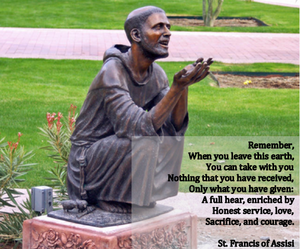
The first aspect was humility. For many of the major features of World Youth Day were inevitably portentous. At times there was even a slight whiff of Catholic triumphalism about what some thought could be the imposition of a heavy Catholic footprint on the contested realities of Sydney’s life and landscape. For understandable reasons, there was much security and practicality bound up in the use of spaces like Barangaroo on the Harbour and Randwick Racecourse. The Franciscans however chose none of those. The major focus of their distinctive contribution was to gather on Bondi Beach. It felt appropriate to the barefoot spirit of Francis and to the demotic character of Sydney and Australia at its best. For Bondi is a people’s place isn’t it? It is life and body affirming. It is accessible and open to all, and to the wider world, and all comers. And, above all, it is intimately bound up in connection and celebration of creation and its elements, not leat the sea, the sand, and the sun. It is an icon of the goodness of earth, translated ‘humus’ in Latin, and is best enjoyed with humility, with a barefoot spirit.
The humility of the Franciscan spirit was also shown in the reconciling way Franciscans organised their World Youth Day celebration. Most of the rest of World Youth Day was inevitably very much a Catholic institutional organisation, to which others might be invited to attend but not to contribute. At times, despite a century of Catholic ecumenism, it even seemed as if other Christians were simply ‘others’ or ‘other faiths’. Like the Taize Community however, the Franciscans had a very differenty approach. From the start of their plans, the New South Wales Ecumenical Council was invited to participate as a full partner. Whilst international Catholic Franciscan luminaries gave a welcome, Anglican Franscicans were also fully included and other Christians were given central space to share and to speak on the main platform, including, notably, the God Squad Christian Motorcycle Club and a female Salvation Army major. Above all the central feature and climax of the whole afternoon was the ecumenical prayer on the main stage, involving representatives of so many different Christian traditions. At the end all of us gathered on the platform released white doves: another beautiful image of the reconciling freedom of Christ which the Franciscan spirit embodies and seeks to share with others.
The third aspect of this Fransciscan freedom in World Youth Day 2008, flowing from humility and reconciliation, was joy. Joy – that is something which cannot be manufactured, can it? It is born of the true freedom of the spirit and from a humble and open heart. It is not a Franciscan possession but it is part of the Franciscan charism and one which not only connects with others but which encourages and enlarges that of others. For one of the greatest things about Wolrd Youth Day was the simple joy of its young participants, from so many places and backgrounds across Australia and the world. For the set-piece events were one thing. The spirit was the key. Indeed, it took Sydney by surprise. Usually full of scepticism and even cynicism, that beautiful but brutally broken, shouting and schizophrenic city was disarmed and even enraptured. Presentiments and plans of problems, protests and confrontations evaporated, through the sheer engaging vibrancy, good humour, openness and joy of the young pilgrims. To get on any of the usually grim commuter trains and buses, was to be greeted with smiles, songs and other gifts, in so many languages.
That spirit of Christ’s freedom – of humility, reconciliation and joy – is, for me, part of the genius of the gift of Francis to us now and always. I have spoken of just one example in time, but I invite you to recall and seek out others, and, still more, to help live and share new ones with others. For, let us make no mistake, it is that spirit of freedom – that humility, reconciliation and joy – which we, all our churches, and our world, so badly need. That is a core part of what this college site stands for and why we are gathered here today in me in particular memory of that long gone barefoot brother whose life and faith might yet just be part of the answer to our struggles today. As the old hymn has it, whatever our own particular name, context and calling, as Francis would aver: ‘give me grace to follow…let me see Your footmarks and in them plant mine own… guide me, call me, draw me, uphold me to the end, and then to rest receive me, my Saviour and my Friend.’ Pax et bonum, Amen.
by Jo Inkpin, for St Francis Day 2018, at St Francis College Brisbane
 RSS Feed
RSS Feed